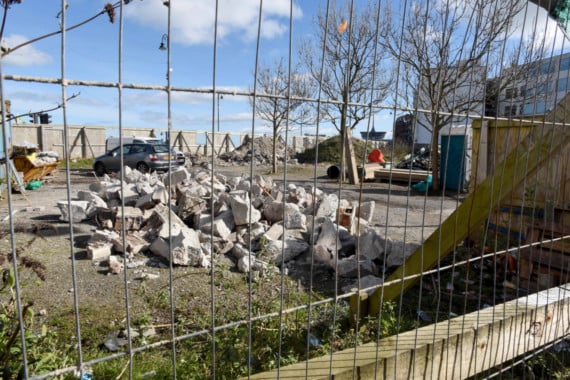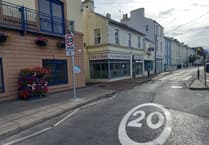It has been empty since the mid 1990s and the subject of several planning applications, yet Douglas councillors can see no light at the end of the tunnel for the Villiers Square grot spot.
Owned by Axa Real Estate Investment, based in Bishopsgate, London, the site has been empty since the demolition of the Athol Hotel in 1994 and has been surrounded by decaying hoardings for years.
And despite occupying a prime spot on what has been referred to as ’the gateway to the island’, weeds, rubble, a skip and general decay and neglect are clearly visible behind the hoardings.
At a meeting, Douglas councillors noted there was an overflowing skip in clear view and resolved to take action to improve the site’s appearance.
Despite some recent improvement, Councillor John Joughin told councillors: ’The whole area is unsightly.’
Council leader David Christian added: ’It’s an eyesore on the promenade right next to the large bus shelter.
’There have been many parties interested in acquiring it from Axa but there have been so many legal issues involved that it’s always fallen through, sometimes after as much as two years.’
He said it needed to be dealt with as an unsightly site. Requiring the owners to seal up the wire mesh openings in the hoardings and repaint them would be a good start, he said. ’That site is going to be empty for many years to come, so we need to improve the overall appearance of it,’ he added.
Powers currently exist, thanks to the Building Control Act, permitting local authorities to serve a notice to repair on the owner of a rundown property or tidy up debris left over from a demolition. In extreme cases, the local authority can step in and complete work then reclaim their expenditure.
Further powers were granted last year providing fixed penalty charges, which can be imposed on owners who are required to complete work on properties and fail to do so, but powers are more limited for empty sites.
The current buildings occupying the corner of Victoria Street and the seafront were completed in 1999, when the Royal Bank of Scotland took up residence there.
In 2002, an access ramp for the basement car parking and landcaping for Villiers Square were completed.
But since then the rest of the site has remained undeveloped.
In 2004, planning permission was granted allowing the site to be developed for a mixture of residential and retail use. When nothing happened, the permission was extended but expired in 2010.
Councillor Ritchie McNicholl, chairman of the council’s environmental services committee, which oversees rundown areas, told councillors the new borough dilapidation officer had been lookng into the matter.
’We are in the process of trying to get the owners’ agent to do something,’ he said.
He added the overflowing skip contained stone from the site fronting Regent Street next to the bookmakers, where work had been done on the gable end.
Axa Real Estate Investment Managers was given planning consent in April 2013 (13/00163/B) for a six storey residential development with underground parking and ground floor retail on the remainder of the Villiers site.
We contacted Axa in London but no one was available to comment in time for the Courier’s deadline.
In 1994 The Independent (the UK newspaper) ran an opinion piece by architectural specialist Gavin Stamp about Douglas before the Villiers was knocked down.
Its headline online was ’The Isle of Mammon is ripping out its soul: The Manx government’s indifference, nay hostility, to conserving its capital, Douglas, is jeopardising a Victorian gem’
The opinion piece reads:
In the middle of the Irish Sea is a place as extraordinary and as fascinating as anywhere in Europe, an island some 30 miles long with a peculiar history and character of its own. ’It is a bit of Ulster set down in the sea, a bit of England, Scotland, Wales and Cornwall, too, a place as ancient as them all, a separate country, Norse and Celtic at once,’ wrote John Betjeman, who loved it. ’The Isle of Man, like Shakespeare, has something memorable for everyone.’
For transport buffs, Man is heaven. The island had its own narrow-gauge steam railway system and one line survives, running southwards from Douglas, the island’s capital. Horse-drawn trams ply the long, curving promenade in Douglas to connect with Edwardian electric trams which take you north to Ramsay and even 2,000ft up to the top of Snaefell, the island’s highest peak. For those who like to go a little faster, there are, of course, the annual TT Races.
For Victorian buffs, the island is a marvel. Douglas is still an old-fashioned and rumbustious seaside resort, full of stuccoed terraces of boarding houses. Betjeman wrote how ’the distant effect is of white paper folded into a concertina and perched here and there and everywhere along the shore.’
These, and lots of cheerful villas, were built by local architects, but talent was also imported from the mainland. There are churches by Pearson, by Clutton, by Caroe and a wonderful one by the young Giles Scott; there are enchanting Arts and Crafts buildings by Baillie Scott who, according to legend, was so seasick on the way to the island that it was a decade before he could bring himself to leave. And then there are earlier buildings: handsome Regency terraces and a few works by George Steuart, architect to the Dukes of Atholl until their interest in the island was bought out by the British government in 1828.
The visitors who will be disappointed, however, are those who hope to see good modern architecture, unless they enjoy taking perverse pleasure in its opposite. For the Isle of Man can boast the worst, the tawdriest, the most insensitive and inept new buildings to be found anywhere in the British Isles. And these are combined with the crudest and most damaging town planning decisions. All that is missing, fortunately, are urban motorways, roundabouts and superstores to complete the picture, for the size of the population cannot justify that level of destruction. Even so, what goes on in Douglas should be studied as a model of what can happen when the planning controls we enjoy in Britain are removed.
To understand this it is necessary to know something of the Isle of Man’s peculiar history. Man is not part of the United Kingdom. It has its own parliament, the Tynwald, founded by Vikings more than 1,000 years ago. Today, Man prospers as a tax haven and as a base for offshore businesses and banking, so the House of Keys is anxious to resist any tendencies that might constrain the island’s model Thatcherite economy.
Man ignored British legislation on corporal punishment and homosexual acts; similarly it long resisted any attempt to establish listed building and planning controls. On my second visit, in 1985, I went to the ancient capital, Castletown, to see ’its box-pewed, three-deckered, still unspoilt church’ (Betjeman) only to find them burning the pews in the yard. This special building was wholly unprotected.
Things are better now: there is a register of historic buildings and there are a few conservation areas. The only body with any statutory right to comment on planning applications is Manx Heritage. The only body that has doggedly fought for the island’s distinctive architectural heritage is the Isle of Man Victorian Society. It has a great battle on its hands. Hitherto, the losses of good Victorian buildings have been isolated, if frequent. Now there is a threat to a large piece of the ’noble sweep’ of the promenade, Douglas’s glory.
With typical hyperbole, Betjeman once compared Douglas Bay with the Bay of Naples (which I don’t think he ever saw), but it is a noble scene with its gentle curve of bay-windowed and stuccoed Victorian buildings stretching along the Loch promenade laid out by Governor Loch in the 1870s. I can think of nothing like it in any other British seaside resort.
What is now threatened is the Villiers Hotel, a large assembly of buildings between Regent Street and Victoria Street. Once the largest hotel in Douglas, the Villiers closed in the late Eighties. It could have been restored, but Man’s Department of Tourism, while subsidising tawdry modern hotels, declined to support this project as the result would not be new. The site has been bought by AXA Equity & Law International, which wants to pull everything down and build offices instead. Manx authorities are doing everything they can to make this happen.
There is, of course, the argument that Douglas need not be stuck in a time warp and should encourage new architecture along with new business. There are, however, many other sites in the town where a fine new building could be a positive asset. Even then, the general standard of new architecture on the island is so abysmal that there is no reason to suppose that what will replace the Villiers will be any better. One has only to look at the illiterate postmodern rubbish that replaced the Peveril Hotel opposite the Sea Terminal to feel pessimistic. It may be, of course, that Equity & Law’s architects, Haworth Tomkins of London, will produce a masterpiece, but as Douglas continues to demolish Victorian buildings without designs for their replacement being published or approved, we cannot tell.
I would not for a moment suggest that the Villiers block or indeed anything along the promenade at Douglas is great architecture. The point is that it is part of a much larger whole which is both special and splendid. What ought to happen is what the Isle of Man Victorian Society advocates, a conventional redevelopment behind a retained facade. This would save a great deal of money, effort, materials, resources and energy.
Douglas, like other British seaside resorts, is suffering from the availability of cheap flights to the sun so that the great influx of visitors by boat from Lancashire and Scotland is a thing of the past.
But the answer, surely, is not to destroy everything which makes Douglas worth seeing but, carefully, to preserve and enhance what gives this ’Naples of the North’ its peculiar and enchanting character.





Comments
This article has no comments yet. Be the first to leave a comment.